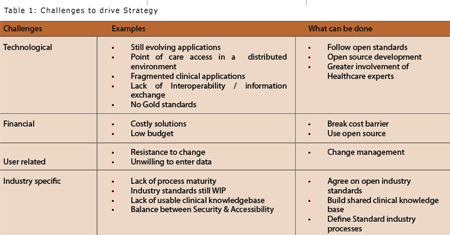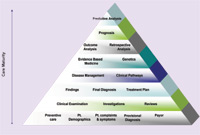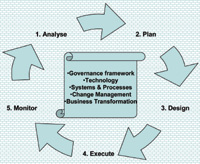Health Informatics @ Max Healthcare : Dr. Dinesh Jain, Medical Informatics Specialist, Max Healthcare
The paper provides an insight into the adoption of Information Technology by Max Healthcare to offer sustainable, cost-effective and quality healthcare services.
Introduction
In today’s world, information has been considered as a strategic source of power empowerment to make timely informed decisions. This fact cannot be overemphasized in healthcare, where an informed decision can be the difference between life and death (or disability) for a patient. Incidentally, most often we find ourselves rich in data yet poor in tools required to convert it to information.

Max Healthcare has continuously invested in Information Systems, from the Hospital Information System (HIS) to Accounting and Financial System, Picture Archiving and Communication System (PACS), Quality Information System, Telemedicine and Business Intelligence. A crucial piece of information that is still missing within the broad picture of healthcare automation relates to the Electronic Patient Health Record, which would contribute, in a large measure to the attainment of medical excellence. Max experience has revealed quite a few insights to the reasons for adopting health informatics, expected end results and the hurdles on the way to achieving them.

Current State
Max Healthcare group utilizes a Hospital Information System for the enterprise wide transaction handling and resource planning. A centralized database with an application running on server-client architecture promotes the aggregation of data from multiple hospitals and gives a unified view. Patient encounters are recorded on the information system with a trail of the services utilized, their consequent material consumption and billing. Flat reports are generated for a multitude of users both for operational tracking as well as for analysis, optimization and strategizing further growth plans for the hospitals. Business intelligence is beginning to play a larger role in the visibility of information and in its ability to drive objective and informed decisions, the ultimate aim of which is to deliver performance. DICOM compatible diagnostic images acquired from CT, MRI, X-Ray, Ultrasound, Gamma Camera, Echo-cardiology, C-Arm etc. are archived and accessed from the PACS. An HL7 (messaging standard for exchange of information in healthcare) engine generates messages from HIS to PACS transmitting the patient demographics, order details to the respective modality worklist.
Accounting and Financial System handles the ledger entries for the transactions recorded in the HIS as well as other expenditure incurred by the organisation in setting up and running new facilities and services. Quality Information System is a unique endeavour to measure and monitor the quality initiatives undertaken by the organisation. A diverse set of parameters are recorded and measured under its ambit, to provide objectivity and transparency to the process of quality improvement.

Drivers of Automation
 Amongst the multitude of reasons driving healthcare automation, these can be broadly classified as internal and external drivers. Internal drivers are those emanating from within the organisation as a response to operational challenges, quality initiatives and organizational drive. External drivers come about as a result of market competition, customer expectations and regulatory requirements.
Amongst the multitude of reasons driving healthcare automation, these can be broadly classified as internal and external drivers. Internal drivers are those emanating from within the organisation as a response to operational challenges, quality initiatives and organizational drive. External drivers come about as a result of market competition, customer expectations and regulatory requirements.

Quality which signifies a degree of excellence is integral to the vision for Max Healthcare. In its quest for excellence, a method for measuring and monitoring performance at every level is worked out, leading to a process oriented system with objective parameters of measurement. Quality pushes the adoption of information systems for reasons like parameterization, data acquisition, aggregation and analysis, performance measurement and monitoring. Parameters like time of action, reasons for delay in discharge process are measured at the point of action and analysed over a period of time to uncover the process & operational inefficiencies and then be able to optimize it.
 Monitoring of operational cost is mandatory for any organization to be able to survive in the competitive environment. This requires an Information System to be in place to support a secure way of handling transactions, store data and present information in an analyzable format. Audits (accounting, process, clinical etc.) depend on this data for assessing the state of affairs and finding gaps or loopholes. Flat reports and Business intelligence provide us the ways of looking at the enterprise data from multiple perspectives, thereby giving us an opportunity to find the inefficiencies and loopholes with an opportunity to improve the systems & processes.
Monitoring of operational cost is mandatory for any organization to be able to survive in the competitive environment. This requires an Information System to be in place to support a secure way of handling transactions, store data and present information in an analyzable format. Audits (accounting, process, clinical etc.) depend on this data for assessing the state of affairs and finding gaps or loopholes. Flat reports and Business intelligence provide us the ways of looking at the enterprise data from multiple perspectives, thereby giving us an opportunity to find the inefficiencies and loopholes with an opportunity to improve the systems & processes.
Efficient utilization of organisational resources is promoted through resource planning which is brought about by the visibility of enterprise wide process and information. Trawling through the information systems, the operational reports capture the slackness in the processes and allow for constant monitoring. An example is a report to compare the admission waiting time and discharge process delay time over a period with bed occupancy and revenue per bed. Once this information becomes available, the decision makers are empowered to take objective & informed decisions, thereby resulting in measurable performance improvement (Fig 1).
 Information systems are called upon to support the practice of Evidence Based Medicine through the provision of Clinical Decision Support Systems, Clinical Pathways, Disease Protocols and Clinical Knowledge-base. Healthcare being an information intensive business, the dissemination of relevant information at every point of healthcare delivery in the process of patient encounter, assumes increasing significance.
Information systems are called upon to support the practice of Evidence Based Medicine through the provision of Clinical Decision Support Systems, Clinical Pathways, Disease Protocols and Clinical Knowledge-base. Healthcare being an information intensive business, the dissemination of relevant information at every point of healthcare delivery in the process of patient encounter, assumes increasing significance.
Market competition, especially at the high end segment, requires a visibility to the enterprise information and an ability to analyse it. In today’s dynamic market conditions, the business offerings are customized according to the customer’s demand, which needs an agile organisation, flexible and responsive to the changing landscape.
Stakeholders Expectations
Once an organisation decides to adopt Information Systems for conducting its business, the stakeholders come to expect a few deliverables and advantages from technology adoption. An expectation of improved business insight, near real time monitoring of processes & consequent objective decision process are at the very top of the stake-holder’s expectation list. All these are expected to lead to an organisation which is agile, responsive and most importantly performs to deliver on the expectations of its customers.
Both clinical excellence programs and clinical research expect useful information through clinical outcome analysis which together with practice of Evidence based medicine is the ‘Holy Grail’ for clinicians (Fig 2). Availability of information and application of knowledge are the pre-requisites for the practice of evidence based medicine, which is becoming almost impossible for an unaided physician to perform under the deluge of information.
 Challenges
Challenges
Why are the success stories so rare when it comes to Healthcare adopting Information systems to transform care delivery? We are aware of the expectations, there are all kinds of tools available, there are multiple drivers pushing automation, still there are major challenges which are proving to be insurmountable in many of the cases (Table 1). The challenges can be broadly classified into:
Learnings
Healthcare today finds itself at crossroads facing three major moving targets:
-
Cost
-
Access
-
Quality
 For healthcare to be sustainable and be able to meet the patient’s requirements, it has to be cost efficient & provide access to quality care (Fig 3). Increasingly the Information Systems are called upon to support these objectives. The benefit of Information Systems adoption in achieving these objectives flows from the following
For healthcare to be sustainable and be able to meet the patient’s requirements, it has to be cost efficient & provide access to quality care (Fig 3). Increasingly the Information Systems are called upon to support these objectives. The benefit of Information Systems adoption in achieving these objectives flows from the following
-
Time – Real time flow of information
-
Place – Remote dissemination of information
-
Standardization – processes & workflows
-
Coordination – care providers
-
Decision support clinical knowledgebase, Clinical pathways & protocols
-
Telemedicine making remote encounters possible
-
Retrospective analysis trends, audits, outcomes
-
Predictive analysis what-if, simulation & modeling
Our past experience has shown that Information Systems themselves do not provide any benefits or answers to an organization’s needs without the simultaneous creation of an ecosystem which will lead and support the implementation of the system. A much greater responsibility rests on the shoulders of the Healthcare management in ensuring that the results match the stakeholder’s expectations.
Transformation Methodology
Implementing an Information System entails wide changes to the organisation, therefore managing the transformation is critical for the success of the endeavour. A planned approach to analyse the requirements and the changes desired, planning the approach to change, design of the change, ution of the change and finally monitor and control the changes effected so as to optimize the results (Fig 4). This cycle is repeated again & again to yield progressive results over multiple iterations.
Key areas where this planned approach needs to be adopted are Governance framework, Technology, Systems & Processes, Change management and Business Transformation.
Innovations and Future Healthcare
Technological innovations are changing the landscape of human society along with the way we interact and conduct business. Social networking has come up in a big way and is defining our relationship with the wider world. Such changes are also impacting the way in which healthcare is demanded and delivered. Yet on a cautionary note, there are inherent risks involved in these radical shifts, some of which are not too apparent at this stage.
Diagnosis on a chip will be enabled through the developments on Gene sequencing and gene activity profile of an individual, which will simplify much of the difficulties associated with remote diagnosis.
Artificial Intelligence is going to aid the diagnostic capabilities of the Physicians, where an ECG interpretation will be built into the system based on the wave form, an image with its attributes would be amenable to intelligent interpretation, so as to link with the disease pathology. Now, more than ever, it is possible to translate the decades of AI research into medical applications which are intelligent enough to support the Physician.
Unified communication is looking to connect an individual to rest of the world using any of the available modes of communication, viz; desk phone, mobile phone, email, sms, fax, public phone etc with a real time tracking of the individual. This would allow a patient to be able to connect to his Physician at the time of an emergency. Networking of devices and IP addressability enables devices like ECG, robotic arm to either broadcast its output to a remote location over the internet or to receive commands over the internet. Such possibilities have started making remote diagnosis and treatment possible. Increasingly remote care would be facilitated by the use of the existing telemedicine diagnostic capabilities married to robotic extensions for carrying out interventions.
The hospital of the future looks increasingly a place where patient encounter is more and more virtual, resulting into an aggregation of resources from around the world onto a single platform for the time honored ritual of diagnosis and delivery of treatment. Yet, there would never be an alternative to the empathy provided by a Physician or a Nurse standing by the bedside, comforting a suffering patient.
To read the complete paper log on to the website:
www.eINDIA.net.in 
uld_count:
Cookie not set
Value 1: 0
Value 2: 10





